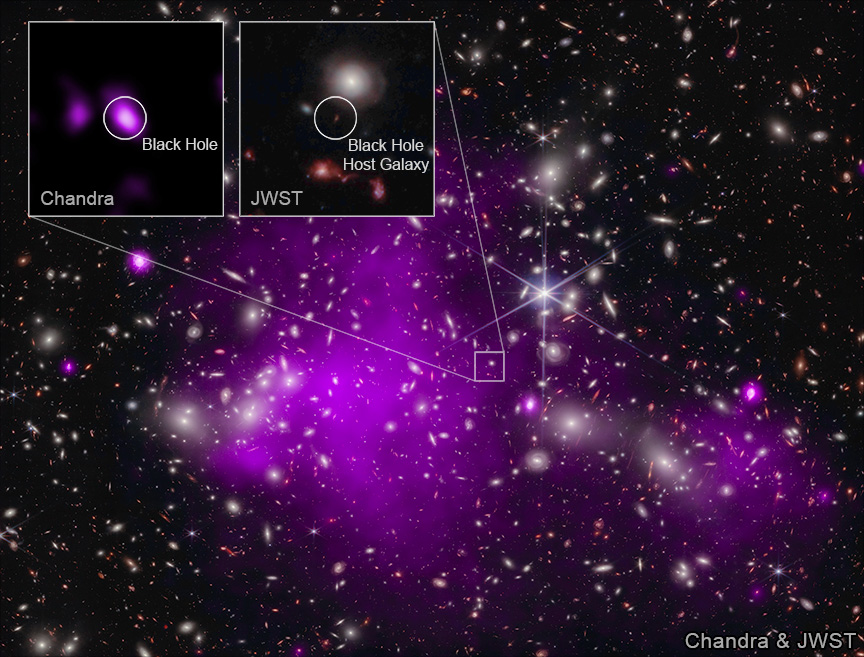
Yale astronomer Priyamvada Natarajan helped do something extraordinary — reach back to the dawn of time to discover the glimmers of an ancient quasar.
Using a pair of space borne telescopes, Natarajan and her research team found UHZ1, just 450 million years after the Big Bang and far outside our own galaxy. Moving farther away as the universe expands, its light took about 1.5 billion years to reach our telescopes.
“It implies that the early universe was quite active,” Natarajan said of the discovery. “We were starting to build a picture of what looks like vigorous star formation; now we see that there was pretty vigorous black hole growth, too.”
A quasar is a growing supermassive black hole at the center of a bright galaxy. The light is emitted by an enormous cloud of gas as it is sucked down into the black hole over eons. Quasars were more common in the early universe, forming before galaxies like our Milky Way. But unlike our Milky Way, or our neighbor the Andromeda galaxy, quasars galaxies are dominated by their central black holes.
The finding, published in Nature Astronomy, helps shed some light on how the oldest, largest, black holes formed. This helps scientists understand how chaos from the Big Bang settled into a universe of stars, galaxies, and planets. Understanding black holes is key to understanding how galaxies were born and how they change.
“They seem to be in the center of every galaxy,” said Natarajan. “So the question is how were they made to start with?”
Black holes are formed when stars very much larger than the sun burn themselves out, collapsing under their own mass. But black holes formed this way are relatively small compared to the ones thought to exist at the centers of most galaxies.
While black holes can grow as they consume more matter, there are some galaxies that are anchored by supermassive black holes that formed very early after the Big Bang — too early to have grown by sucking down stars and gas.
Alex Filippenko, astronomy professor at the University of California Berkeley, said that such black holes “strained the models” for how fast a black hole could grow.
So how did black holes get big enough to start forming galaxies in the early universe?
Natarajan had hypothesized back in 2017 that in the early universe, dense clouds of gas could directly collapse into black holes without needing to become stars first. These “heavy black hole seeds” could grow into supermassive black holes, the sort that anchor galaxies.
UHZ1, fit her criteria. The age of the quasar was old enough that it had to have been born just after the universe began. The size made it a supermassive black hole. The X-rays and light showed it was at the center of a small galaxy. UHZ1 had to have been “born big” and born early. It is evidence that black holes could form without stars.
Using the James Webb Space Telescope, Natarajan’s team was able to find the distant light of the quasar UHZ1. But it was so faint that in order to see it they needed to find a natural magnifying glass — the gravity well of a cluster of distant galaxies — to bend and enhance the distant light.
Later the Chandra X-ray Observatory, launched in space by NASA 23 years ago, was trained on UHZ1. Over the course of two weeks, it detected a powerful emission of X-rays, the signature of a supermassive black hole.
“This study has my highest compliment in that I wish I had thought of this project and proposed it myself,” said Filippenko.
UHZ1 is small for a galaxy, about 10 to 100 million times the mass of the sun. The black hole at its heart is about the same mass as the galaxy surrounding it. The light it produces is “red shifted” stretched out as it retreats across the cosmos as the universe expands.
In contrast the Milky Way is between 890 to 1.54 trillion times the mass of the sun. The black hole at the center of the Milky Way, Sagittarius A, is about 4.1 million times the mass of the sun, much smaller in proportion to the rest of the galaxy.
“If you have multiple processes that lead to the formation of the first black holes, we can explain why we see them so ubiquitously,” said Natarajan. “The curtain is lifting.”
These supermassive black holes would be drawn by gravity into nearby collections of gas, early stars, and other objects, forming a galaxy, she said.
“One can say we are here today because of our black hole, the black hole in the center of the Milky Way,” said Natarajan. “It was fundamental to the shaping of our galaxy.”
